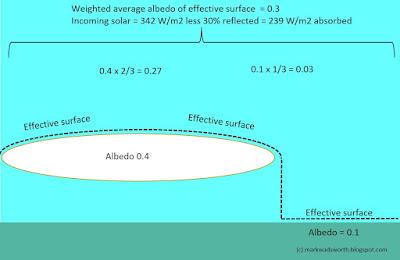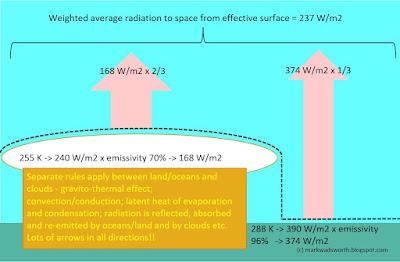I have shown that the logic behind so-called '33 degree greenhouse effect' is naive to the point of being meaningless and/or deliberately totally misleading.
Now let's look at the next layer of piffle; the so-called 'energy budget':
 Most of the numbers in the arrows are correctly calculated and pointing in the right direction, if looked at in isolation. But because the logic is so deeply flawed and so many facts are simply ignored, we end up with the smoking gun arrow showing 324 W/m2 of 'back radiation' from 'greenhouse gases'.
Most of the numbers in the arrows are correctly calculated and pointing in the right direction, if looked at in isolation. But because the logic is so deeply flawed and so many facts are simply ignored, we end up with the smoking gun arrow showing 324 W/m2 of 'back radiation' from 'greenhouse gases'.
They are claiming that tiny amounts of CO2 and gaseous water vapour (about 0.04% and 0.1% of the atmosphere by mass respectively) magically shine as brightly as the Sun, if measured in terms of energy being radiated to Earth. That in itself must strike the casual observer as completely fatuous.
The 324 W/m2 is just a balancing figure that doesn't exist in the real world! You can't just add and subtract 'radiation' at different intensities and frequencies anwyay, it is far more complicated than that. Imagine a 3,000 Watt three-bar electric fire versus a 3,000 Watt radio transmitter!
That diagram is so appalling, that it's easier starting from scratch than it is correcting all the compounding errors, so here goes.
1. Basic physics says that the surface of a planet will warm (or cool) to the temperature at which is emits as much radiation to space as it receives from space i.e. from the Sun, that is its 'effective temperature'. Let's look at solar radiation first. We are looking at 'effective temperature' so we also have to look at how much solar radiation the 'effective surface' (this is my term, I haven't found an official one) absorbs. We do this by reducing solar radiation by the amount reflected (by the 'albedo'). The weighted average albedo of the effective surface (2/3 clouds and 1/3 oceans/land) is 0.3, so we reduce incoming solar from 342 W/m2 to 239 W/m2:
 This number has been estimated at anything between 235 W/m2 and 240 W/m2, but Believers and Sceptics alike appear to accept it, as shall I.
This number has been estimated at anything between 235 W/m2 and 240 W/m2, but Believers and Sceptics alike appear to accept it, as shall I.
2. OK, the effective surface is absorbing 239 W/m2. Does it also emit 239 W/m2? If not, then we need an explanation (most people will assume 'greenhouse gases'). If it does, then AGW Theory is yet again debunked, and we don't need any further explanations.
We know the temperature and emissivity of both parts of the effective surface (oceans/land and clouds), so we can calculate how much radiation each is emitting using Stefan-Boltzman formula and adjusting for emissivity. We then take a weighted average of both, and... what a coincidence... the effective surface is emitting 237 W/m2 on average. Which is so close to the incoming 239 W/m2 absorbed (calculated above) as makes no difference (bearing in mind all the approximations and uncertainties involved):
 That's it, that's the end of the line. There is yet again no big discrepancy that needs to be explained. Solar energy absorbed = infra red energy emitted. If you just make realistic assumptions and apply basic physics (and completely ignore 'back radiation' and 'greenhouse gases'), you end up with a very plausible result. Therefore, your assumptions must be broadly correct (or at least, there's no evidence to say that they aren't). It seems to me impossible to splice in the 324 W/m2 of 'back radiation' without ending up with a nonsensical answer. End of.
That's it, that's the end of the line. There is yet again no big discrepancy that needs to be explained. Solar energy absorbed = infra red energy emitted. If you just make realistic assumptions and apply basic physics (and completely ignore 'back radiation' and 'greenhouse gases'), you end up with a very plausible result. Therefore, your assumptions must be broadly correct (or at least, there's no evidence to say that they aren't). It seems to me impossible to splice in the 324 W/m2 of 'back radiation' without ending up with a nonsensical answer. End of.
3. What is really interesting is what goes on inside the amber box. That is heinously complicated and nobody really knows. Maybe the ficitious 324 W/m2 is in there somewhere, so it's relevant to the tmeperature balance between oceans/land and clouds, but it is irrelevant to what gets to space and so shouldn't be on the first chart at all.
Why does only one-tenth of 1% of 1% of all water on Earth end up as clouds? Why are clouds at the altitude they are? You'd need several degrees in physics and meteorology to even be able to understand the ground rules, let alone put numbers on the effects and work out how all they all interact (positive and negative feedbacks etc) to end up with things the way they are.
Needless to say, plenty of people have looked at isolated aspects of this; but even if somebody every aspect and explained how it all interacts, it I doubt I'd be able to follow and would end up taking it on trust. But no 'climate scientist' cares about these finer details, so why should I?
